
Concept explainers
a.
To approximate:
The fork length of each given species of shark to the nearest centimeter if the shark’s total length is 250 centimeters.
a.
Answer to Problem 39E
Fork length of Bigeye thresher is 158 centimeters.
Fork length of scalloped hammerhead is 194 centimeters.
Fork length of white shark is 230 centimeters.
Explanation of Solution
Given:
The fork length of a shark is the distance from the tip of the shark’s snout to the fork of its tail, as shown:
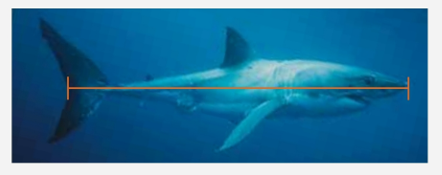
The table lists equations giving the fork length f as a function of the total length t for three species of sharks, where both f and t are measured in centimeters.

Calculation:
To find the fork length of each species of shark, we will substitute
Therefore, the fork length of Bigeye thresher is 158 centimeters.
Therefore, the fork length of scalloped hammerhead is 194 centimeters.
Therefore, the fork length of white shark is 230 centimeters.
b.
To find:
For each species of shark, what percent of the total length does the fork length represent if the shark is 250 centimeters long? Round your answers to nearest percent.
b.
Answer to Problem 39E
Fork length of Bigeye thresher is 63% of total length.
Fork length of scalloped hammerhead is 78% of total length.
Fork length of white shark is 92% of total length.
Explanation of Solution
Given:
The fork length of a shark is the distance from the tip of the shark’s snout to the fork of its tail, as shown:
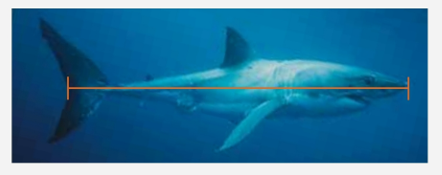
The table lists equations giving the fork length f as a function of the total length t for three species of sharks, where both f and t are measured in centimeters.
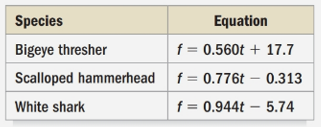
Calculation:
We will find the fork length of each species is what percent of total length as:
Therefore, the fork length of Bigeye thresher is 63% of total length.
Therefore, the fork length of scalloped hammerhead is 78% of total length.
Therefore, the fork length of white shark is 92% of total length.
c.
Which species of shark do you think has the longest tail relative to its body size? Explain your reasoning.
c.
Answer to Problem 39E
The white shark has the longest tail.
Explanation of Solution
Given:
The fork length of a shark is the distance from the tip of the shark’s snout to the fork of its tail, as shown:
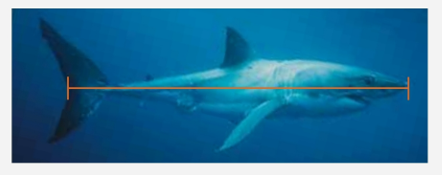
The table lists equations giving the fork length f as a function of the total length t for three species of sharks, where both f and t are measured in centimeters.
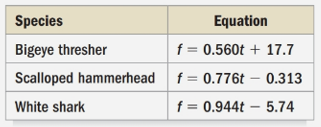
Calculation:
We can see from the calculations of part (a) and part (b) that white shark has the longest fork length and its fork length is 92% of the total length.
Therefore, the white shark has the longest tail.
Chapter 8 Solutions
Holt Mcdougal Larson Pre-algebra: Student Edition 2012
Additional Math Textbook Solutions
Introductory Statistics
College Algebra with Modeling & Visualization (5th Edition)
Elementary Statistics
Elementary Statistics (13th Edition)
Calculus: Early Transcendentals (2nd Edition)
Thinking Mathematically (6th Edition)
- Round as specified A) 257 down to the nearest 10’s place B) 650 to the nearest even hundreds, place C) 593 to the nearest 10’s place D) 4157 to the nearest hundreds, place E) 7126 to the nearest thousand place arrow_forwardEstimate the following products in two different ways and explain each method  A) 52x39 B) 17x74 C) 88x11 D) 26x42arrow_forwardFind a range estimate for these problems A) 57x1924 B) 1349x45 C) 547x73951arrow_forward
- Draw the image of the following figure after a dilation centered at the origin with a scale factor of 14 退 14 12- 10 5- + Z 6 的 A X 10 12 14 16 18 G min 3 5arrow_forwardkofi makes a candle as a gift for his mom. The candle is a cube with a volume of 8/125 ft cubed. Kofi wants to paint each face of the candle exepct for the bottom. what is the area he will paint?arrow_forward10 6 9. 8 -7- 6. 5. 4- 3. 2 1- -1 0 -1 2 3 4 ·10 5 6 7 00 8 6 10arrow_forward
- Week 3: Mortgages and Amortiza X + rses/167748/assignments/5379530?module_item_id=23896312 11:59pm Points 10 Submitting an external tool Gider the following monthly amortization schedule: Payment # Payment Interest Debt Payment Balance 1 1,167.34 540.54 626.80 259,873.20 2 1,167.34 539.24 628.10 259,245.10 3 1,167.34 With the exception of column one, all amounts are in dollars. Calculate the annual interest rate on this loa Round your answer to the nearest hundredth of a percent. Do NOT round until you calculate the final answer. * Previous a Earrow_forwardCafé Michigan's manager, Gary Stark, suspects that demand for mocha latte coffees depends on the price being charged. Based on historical observations, Gary has gathered the following data, which show the numbers of these coffees sold over six different price values: Price Number Sold $2.70 765 $3.50 515 $2.00 990 $4.30 240 $3.10 325 $4.00 475 Using simple linear regression and given that the price per cup is $1.85, the forecasted demand for mocha latte coffees will be cups (enter your response rounded to one decimal place).arrow_forwardGiven the correlation coefficient (r-value), determine the strength of the relationship. Defend your answersarrow_forward
- ??!!arrow_forwardrections: For problem rough 3, read each question carefully and be sure to show all work. 1. Determine if 9(4a²-4ab+b²) = (6a-3b)² is a polynomial identity. 2. Is (2x-y) (8x3+ y³) equivalent to 16x4-y4? 3. Find an expression that is equivalent to (a - b)³. Directions: For problems 4 and 5, algebraically prove that the following equations are polynomial identities. Show all of your work and explain each step. 4. (2x+5)² = 4x(x+5)+25 5. (4x+6y)(x-2y)=2(2x²-xy-6y²)arrow_forwardName: Mussels & bem A section of a river currently has a population of 20 zebra mussels. The population of zebra mussels increases 60 % each month. What will be the population of zebra mussels after 2 years? 9 10 # of months # of mussels 1 2 3 4 5 6 7 8 o Graph your data. Remember to title your graph. What scale should be used on the y-axis? What scale should be used on the x-axis? Exponential Growth Equation y = a(1+r)*arrow_forward
 Algebra and Trigonometry (6th Edition)AlgebraISBN:9780134463216Author:Robert F. BlitzerPublisher:PEARSON
Algebra and Trigonometry (6th Edition)AlgebraISBN:9780134463216Author:Robert F. BlitzerPublisher:PEARSON Contemporary Abstract AlgebraAlgebraISBN:9781305657960Author:Joseph GallianPublisher:Cengage Learning
Contemporary Abstract AlgebraAlgebraISBN:9781305657960Author:Joseph GallianPublisher:Cengage Learning Linear Algebra: A Modern IntroductionAlgebraISBN:9781285463247Author:David PoolePublisher:Cengage Learning
Linear Algebra: A Modern IntroductionAlgebraISBN:9781285463247Author:David PoolePublisher:Cengage Learning Algebra And Trigonometry (11th Edition)AlgebraISBN:9780135163078Author:Michael SullivanPublisher:PEARSON
Algebra And Trigonometry (11th Edition)AlgebraISBN:9780135163078Author:Michael SullivanPublisher:PEARSON Introduction to Linear Algebra, Fifth EditionAlgebraISBN:9780980232776Author:Gilbert StrangPublisher:Wellesley-Cambridge Press
Introduction to Linear Algebra, Fifth EditionAlgebraISBN:9780980232776Author:Gilbert StrangPublisher:Wellesley-Cambridge Press College Algebra (Collegiate Math)AlgebraISBN:9780077836344Author:Julie Miller, Donna GerkenPublisher:McGraw-Hill Education
College Algebra (Collegiate Math)AlgebraISBN:9780077836344Author:Julie Miller, Donna GerkenPublisher:McGraw-Hill Education





